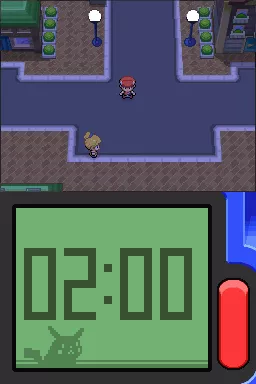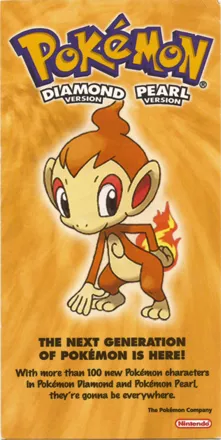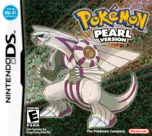Pokémon Diamond Version
Description official descriptions
Together with Pokémon Pearl, this game starts the 4th generation of the Pokémon series. Set in a new region, Sinnoh, it includes 107 new Pokémon, bringing the total up to 493. It is also the first online game in the series, featuring Wi-Fi battles and trading. Players can collect badges, challenge the Elite Four, and become the ultimate Pokémon master.
The game continues the basic idea of previous Pokémon games - you, a new trainer, set out on a quest to catch every Pokémon and defeat the Pokémon league. Along the way, you will foil the plots of the evil organization Team Galactic, who seek to use a trio of legendary Pokémon to awaken a sleeping titan with the power to control time. There are many sidequests and other activities along the way, including the Battle Tower and catching other legendaries.
The core Pokémon series features an RPG turn-based battle system. Each monster can learn up to four attacks. In a single turn, the two opponents select their attacks, and the one with the higher Speed attacks first. The amount of damage is influenced by the Attack and Defense stats. In the past, attacks were automatically classified as Physical or Special based on their elemental type. In Diamond and Pearl, each attack can be individually categorized, so attacks which use natural elements are Special, and those which use simple force are Physical.
The Pokémon Contests from Ruby and Sapphire return, with many new features. In addition to the attack performance, where you must try to impress the judge with flashy moves, you'll also dress up your Pokémon and dance in time to music. Diamond and Pearl also bring back the real time system from Gold and Silver, where day and night are reflected in your game. Some Pokémon are only catchable during certain times.
Spellings
- ポケットモンスター ダイヤモンド - Japanese spelling
Groups +
- Gameplay feature: "Simon says"
- Gameplay feature: Botany, farming, gardening
- Gameplay feature: Creature breeding / fusion
- Gameplay feature: Day / night cycle
- Gameplay feature: Fishing
- Gameplay feature: Gambling
- Gameplay feature: Importable characters
- Gameplay feature: Interior decorating
- Gameplay feature: Journal
- Gameplay feature: Mining
- Gameplay feature: Monster capture / training
- Gameplay feature: Recordable replays
- Games made into books
- Games made into comics
- Games made into movies
- Games made into TV series
- Games released as complementary versions
- Pokémon main RPG series
- Pokémon universe
- Protagonist: Female (option)
Screenshots
Promos
Credits (Nintendo DS version)
129 People (96 developers, 33 thanks) · View all
| Director | |
| Art Director | |
| Battle Director | |
| Program Leader | |
| Battle System Programmer | |
| Field System Programmer | |
| Communication System Programmer | |
| Programmers | |
| Graphic Leader | |
| Pokémon Designers | |
| [ full credits ] | |
Reviews
Critics
Average score: 84% (based on 33 ratings)
Players
Average score: 3.8 out of 5 (based on 42 ratings with 2 reviews)
If it ain't broke, why fix it?
The Good
For those who haven't played any of the Pokémon Games: Pokémon is a game in which you travel around the land to capture a wide variety of creatures called pokémon. Pokémon come in many sizes and shapes. You can not only collect them but you'll also battle with them. Since there is a wide variety of pokémon, there is also a wide variety of strengths and weaknesses. These are determined by element-types. Water beats Fire, which beats Grass, but Grass is dominant over Water etc. This combined with many different abilities, techniques and sometimes a secondary element-type, makes for a pretty complex battle system. The pokémon will fight with moves that have those element-types, too, which determines whether or not the opponent pokémon will be weak against them. They will level up after earning points and most of them will eventually transform into more mature and more evolved forms. You can carry up to six with you while you store the others in a Day-Care or Pokécenter. You can battle wild pokémon but you will also be challenged by other trainers. Each version also lacks certain species that need to be traded with the other one. (This review is based on the Diamond version. Pearl is mostly the same but has certain pokémon not available in Diamond and vice versa.)
When pokémon first came out on the Game Boy more than a decade ago, it was a rather simple RPG at first glance but, as you would find out soon, it was very complex. It quickly grew into an enormous craze spawning many new games, cartoons, T-shirts etc.
The sequels that have been released over the years improved the games to make them more and complex, more entertaining and more challenging. The game mostly improves on the DS-unique features such as the touch-screen. Navigating menus in battles is now a breeze and works really nice.
Another big improvement is the support for online play. One of the series' best parts has always been the multiplayer. Swapping over pokémon is needed to collect every last one of them. It's now easier than ever to trade. Not only can you trade with people in your friend-code roster, but there is also the Global Trade Center or GTS, for short. This building allows you to put up a certain pokémon and tell what you want in exchange for it. You can also seek pokémon to see what people have the ones you're looking for and what they want in return. Naturally, battles are also compatible with online play. Gather some friend codes and give your code to your friends and you can battle with your friends from all over the world. The Wi-Fi mode is clearly the biggest advancement and makes this game still fun for pokémon newcomers as well as veterans alike. This will give you a new challenge without having to leave the house. The Battle Tower, which fans will find familiar, supports Wi-Fi, too. You can even upload your team there for others to battle without playing yourself. Another neat feature is the voice chat support. The game supports the headset, too, much like Metroid Prime: Hunters. What sets Pokémon Diamond/Pearl apart from that game's online mode, though, is the fact that you can even chat during gameplay. Text chat is also available. The Wireless LAN connection is here, too. This way you can also link with your friends down the street like you would back in the late 90's, but without having to use a link cable. Another cool feature is the Underground in which you can find some very rare items and make a secret base. (like the ones in the GBA versions) You can also find gems here that you can grow when you bury them and use as money for furniture and dolls to put in your base. You can also buy traps for Capture the Flag, which is played via Wireless LAN and places your flag in your secret base.
Previous games had the PokéGear and PokéNav, Diamond/Pearl has the Pokétch, a watch full of cool features that are just nice gimmicks or really useful. It's much more sophisticated than before and appears on the touch screen. As you play the game you will receive more apps. These include things like a watch, a drawing pad, an app that enables you to find secret items and many more.
Though the formula didn't change very much over the years, it still stands strong as one of the most addictive and entertaining concepts. There still is a world map in typical RPG-style on which you encounter wild pokémon in caves, grass, volcanoes, cities etc. and other trainers with their own pokémon. You catch them inside pokéballs, breed them, battle them, level them up, make them evolve into higher forms and try to become the best trainer in the land along the way by collecting badges of merit. Not much has changed but it's such a good formula that Game Freak's conservatism on this point is perhaps a good thing. A good thing is the fact that day/night effects are back from the GBC versions after being absent for some reason on the GBA. This is very cool, since some pokémon are nocturnal and won't come out until nightfall whilst others don't appear at night. Some pokémon only evolve in certain times of the day, which makes this feature even more complex.
The story is mostly the same as before. You are a young trainer trying to get all the League Badges to gain access to the Pokémon League and collect as much pokémon as possible. There is still a professor who gives you your first critter as well as his grandson who is your rival in pokémon training.
The music, while not the most amazing thing you've ever heard, is still uplifting and you'll soon find yourself humming along with the tunes, especially the battle-screen tunes.
While the main adventure can be completed within a few days, you'll likely keep playing much, much longer. A few new areas will open up to explore and there is just so much small things to discover even after weeks of playing. Obtaining all pokémon will cost months, if not years. There's almost a whopping 500 of them now, including over a 100 new ones! Finding out how to get them takes a lot of patience and is sometimes done in new and unique ways. There are many cool and collectible items with special effects to give to your pokémon, such as berries, medicine and evolution items. Then there is always a team that you can train into the most perfect pokémon, with the most perfect attacks and type-balance to unleash on the Wi-Fi mode. A cool new feature is a place called Pal Park in which you can send over pokémon you trained on the GBA versions and put them back in pokéballs there. They keep their stats, nicknames and items, too. Some pokémon don't appear in both games but can be obtained that way. This series has always done an amazing job in replay value and now it's even better than before as there is most likely a potential for more than a 100 hours of gameplay.
The Bad
While the Wi-Fi mode makes it still a worthy title, I feel the formula, while being very complex and interesting, is getting a bit old. Other than the online play, there aren't as much improvements as previous pokémon games had over their predecessors.
Furthermore, the graphics haven't changed much. The buildings are now 3D models and there are some realistic weather effects. Apart from that it's mostly just sprites, many of which are recycled art from the GBA versions. Seeing the DS is capable of so much more, the game could have had much better graphics and it's a pity Game Freak has remained very conservative when it comes to graphics.
Though the music is pretty nice, the sound effects are not as good. The cries of older pokémon are still the same as in the old GB versions but the new pokémon sound way better. This is weird and the older sound effects are not up to the DS's standards. This may appear weird to players who first play a pokémon games.
Another thing that feels uninspired are some of the pokémon themselves. Most of them are very similar to older ones. This may make those who played earlier games, feel like they are doing something they have done before. To make things even worse, a lot of them actually evolve from or into older pokémon. This makes you wonder if you want to catch them all over again plus more than a 100 new ones.
There are a few things that keep the online mode from being prefect, too. You need friend codes for battles in the pokécenter Wi-Fi club, which is a shame. Metroid Prime: Hunters and Mario Kart DS can seek opponents but Pokémon can't do that. The GTS also has a bit of problems when it comes to fair trading. Many people will ask for pokémon that are rare, powerful and trained to their extremes while offering a pokémon that just hatched from an egg. Wi-Fi doens't support the Underground area, which is a real shame.
You can't send back pokémon to your GBA games once they are transferred to Pal Park.
The Bottom Line
Not much has changed but the DS capabilities such as touch-screen menu navigation and, most notably, the online mode make up for that. Wi-Fi will likely make up for the lack of innovation for old-time fans while it will appeal to new players alike. One of the few games with good GBA-port to DS-port connection, too.
Nintendo DS · by Rensch (203) · 2007
A must-have game for DS owners, Pokemon fans or not!
The Good
The ideas are kept fresh, with compatibility with both past games (GBA) and future games (Pokemon Battle Revolution). New evolutions are added, and Pokemon collectors will have to play like crazy in order to complete the National (Poke)Dex. The replay time: INFINITY! Anyone with a game from Hoenn, Kanto, or Sinnoh can connect. Perfect balance of In-Game legendaries, event legendaries, and glitches (Yay!), Pokemon Diamond (or Pearl) is definitely a choice to consider with your allowance or paycheck!
The Bad
Some factors could only be gotten via friends (Spiritomb, National Dex, etc.), and I no likie! Multiplayer is fun, but should not be required to (fully) complete the game. Plus most of the glitches result in sending your game to Japan or getting a new one. Nintendo could have spent a little more time developing this game.
The Bottom Line
A great game with excellent connectability, play time, and fun. Pokemon Fans Beware: This game may cause you to lose the will to play any other game, even that brand new Wii (with the exception of Pokemon Battle Revolution) you got for your Birthday. NO ONE ESCAPES THE PULL OF POKEMON DIAMOND (OR PEARL)!
Nintendo DS · by Fishaman P (33) · 2008
Discussion
| Subject | By | Date |
|---|---|---|
| Global trading bozos | Joshua J. Slone (4666) | Jun 21, 2007 |
Trivia
1001 Video Games
Pokémon Diamond Version appears in the book 1001 Video Games You Must Play Before You Die by General Editor Tony Mott.
References
- After defeating the first Gym Leader in the US version, the following message appears: "In return, we'll refrain from causing massive damage to your assistant. This is a reference to Genji: Days of the Blade, read the trivia item there for more information.
- A Wooper trainer in Jubilife City is named Roxy in the English version of the game. This references a well-known Let's Play of Pokémon Crystal on the website Something Awful, in which the player character was named Roxy and kept a Wooper in her main team. The game's lead translator, Nob Ogasawara, is an active member of the site and a recurring commenter in its Pokémon threads.
- Shortly after starting a new game, a news story on the player's TV mentions an "oddly colored" Gyarados. This is a reference to the shiny Gyarados that can be found in the Pokémon Gold Version and Pokémon Silver Version Game Boy games.
- On January 12 (Junichi Masuda's birthday), fly up to Snowpoint City and instead of the usual flurry snow storm there will be glittery diamond snow.
- The Pokémon Rotom, first introduced in this game, is based on the eponymous character of an earlier Game Freak game called Pulseman. Additionally, Team Galactic's Japanese name translates to Galaxy Gang, a name shared by Pulseman's antagonists.
Sales
According to publisher Nintendo, Pokémon Diamond Version together with Pearl Version sold 17.63 million copies worldwide (as of September 30, 2015).
Awards
- GameSpy
- 2007 – #3 Handheld Game of the Year (together with Pokémon Pearl Version)
- 2007 – #2 Nintendo DS Game of the Year (together with Pokémon Pearl Version)
- 2007 – Nintendo DS RPG of the Year Pokémon Pearl Version)
Information also contributed by Dracozon
Analytics
Identifiers +
Contribute
Are you familiar with this game? Help document and preserve this entry in video game history! If your contribution is approved, you will earn points and be credited as a contributor.
Contributors to this Entry
Game added by LordRM.
Additional contributors: Jeanne, Sciere, Alaka, gamewarrior, DarkDante, Yearman, Sicarius, CalaisianMindthief, Patrick Bregger, Michael Cassidy, FatherJack, Harmony♡.
Game added April 22, 2007. Last modified October 15, 2024.




















